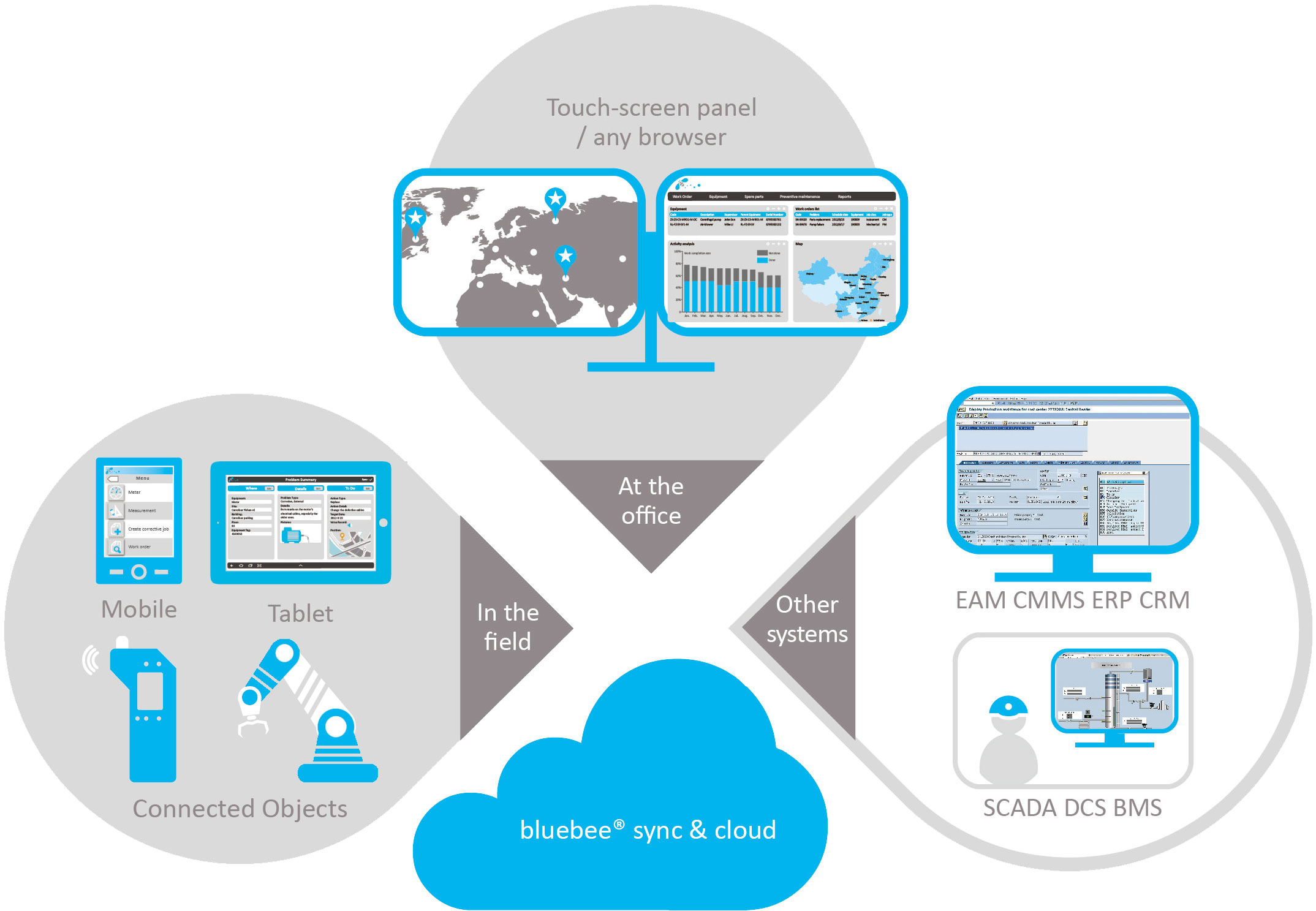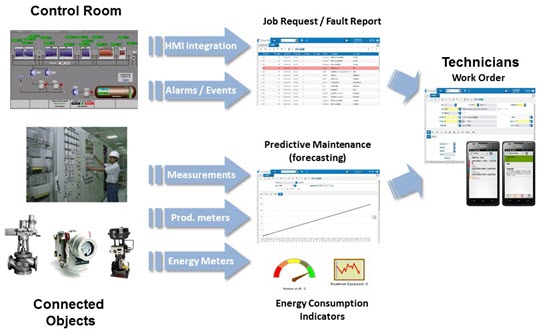IoT integration for Maintenance 4.0
Long before the term IoT was coined, Siveco’s maintenance management systems were already making use of data from sensors, supervisions and control systems, to enable predictive maintenance and better management decisions. The technologies developed by Siveco have proven particularly agile to benefit from today’s IoT advances, increasingly connected machines and new cloud-based services. Today, the bluebee® lab, located in Shanghai, is at the forefront of IoT applications for Maintenance 4.0.
The IoT integration platform
A true Maintenance 4.0 solution, Siveco’s suite of products is designed to flexibly integrate not only with state-of-the-art Industry 4.0 or Internet of Things (IoT) technology, but also with legacy systems, thus avoiding their premature replacement. Siveco provides a standard two-way integration toolkit, to communicate with Connected Objects, as well as traditional automation and condition monitoring systems (DCS, SCADA, BMS, CMS, etc.), bringing unique benefits to facilities operators.

The toolkit is available as part of bluebee® sync, when bluebee® mobile or cloud solutions are involved (usually for multisite risk management applications), and as a Coswin 8i interface module for stand-alone Coswin 8i projects (usually plant maintenance applications).
Unlike traditional interfaces, which feature a transfer of data to trigger work orders in the CMMS, often without practical application other than replacing the phone and sometimes with unwanted results, such as thousands of repeated or false alarms accumulating in the CMMS database, the Siveco integration approach was designed by maintenance experts to bring true value-added to both operation and maintenance users.
The integration platform is independent from third-party vendors and has already been applied to various IoT and DCS/SCADA systems, including those of: IoT cloud providers Baidu, Amazon; automation suppliers ABB, ACOEM, Emerson, GE, Schneider Electric, PCVue, Yokogawa, etc.; as well as many more specialized or lesser-known solution providers.
HMI integration
With the standard integration monitoring integration toolkit, both systems’ HMI can be integrated, meaning that operators can view CMMS data and access its functionalities from the control system HMI. This seemingly simple feature provides unheard-of support for work productivity improvement, fault diagnosis, safety management and decision-making.

Example view ongoing maintenance work in the CMMS from the DCS screen
Data exchange
Alarms, measurements and meters are automatically transferred to the CMMS after processing in the control system or for further processing in the CMMS.
Traditional CMMS are usually designed to only receive data, but are not able to treat them apart from automatically launching a work order. In practice this leads to a confusing accumulation of work orders that do not deserve the maintenance department’s attention. It also reinforces a reactive approach to maintenance (reacting quickly to alarms or problems) – in fact corrective maintenance – rather than the true preventive maintenance is was intended to enable.
In contrast, Siveco solutions are able to roughly forecast the next maintenance date, based on trends and historical records and to already plan the work order. When the IoT data finally reach the defined threshold, the already-planned work order is simply released.
As part of the implementation project, Siveco’s maintenance experts will review the client’s actual maintenance strategy and, more particularly condition monitoring and predictive maintenance, in order to determine how the IoT or DCS/SCADA integration should be carried out. While the platform should be robust, it is this industrial-focused rather than IT approach that is the true secret to success.

Standardization
While it is always possible to interface different systems through specific software development work, design mistakes, bugs, unforeseen problems (due to large amount of data for example) may result in poor reliability. Upgrade of any one of the system will often require redeveloping the interface. Long term support may be problematic and costly.
Using bluebee® sync, no software development is required. Siveco believes that using standard off-the-shelf components, the integration toolkit, vastly increases reliability and considerably reduce Total Cost of Ownership over time (support, upgrades and modifications).
Security
In a world where cyber-threats have become a major concern, the security of the automation system must remain absolute. As far as maintenance is concerned, the CMMS should never disrupt operations: communicate is strictly one way, the CMMS does not control the facility. The Siveco standard integration toolkit, part of bluebee® sync, ensures a fail-safe design.
A long history
Siveco Group draws on over 30 years of experience integrating with automation and monitoring systems: a concept that only became popular among CMMS suppliers in the 2000s and still today is considered “advanced” by vendors and clients alike, as successful implementations are few and far between. Siveco has been doing it successfully for 30 years! As part of its innovation program, Siveco Group has worked with leading universities and government-sponsored research programs (such as the European PROTEUS program), working on interoperability issues with leading automation system vendors as well as major plants operator-owners from both the private and public sector.
In the years 2000s, Siveco pioneered user interface (or HMI – Human Machine Interface) integration, allowing control room operators to access relevant maintenance data with a few clicks. Coswin 7i was the first CMMS to such HMI integration as a standard feature, which lead to close cooperation with leading automation vendor ABB, which promoted a similar approach. Siveco later extended HMI integration to other systems such as GIS and BIM, which great success.
In 2008, the bluebee® lab was created, Siveco R&D center located in Shanghai, China. While Siveco France R&D focuses on Coswin (now in its 8i version), the bluebee® lab has been dedicated to mobile solutions and more generally the design of innovate Human Machine Interfaces. The first IoT developments were carried out by Siveco China in 2010 and were immediately implemented on a large-scale by customer Carrefour China (the project won a China Supply Chain Award in 2013).
For more information on our IoT solutions for Maintenance 4.0, contact us at info@sivecochina.com or call our hotline 4006-300-213.




